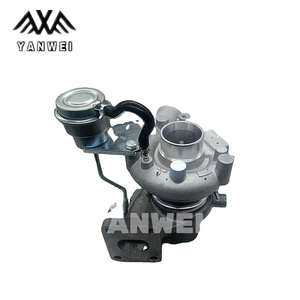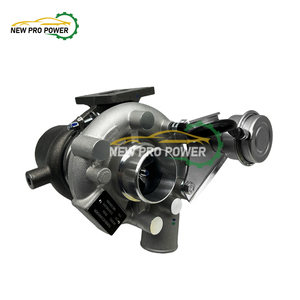(451 products available)




































































































































































4d34 turbocharger refers to a turbocharger used in the 4D34 engine, commonly found in diesel engines like the Mitsubishi 4D34. The 4D34 turbocharger compresses the intake air, increasing its density so more air can enter the combustion chamber, improving engine efficiency and power output.
4D34 turbochargers can be divided into four major types:
Single turbocharger
In a single turbo setup, one turbocharger is used to boost the air into the engine. This is the most commonly used configuration. Single turbochargers are further divided into numerous types based on the compressor and turbine wheel designs. Some of the most popular types include:
Axial turbochargers: These feature a compressor wheel with blades arranged in a radial pattern. They are known for their high efficiency and ability to generate high airflow rates, making them ideal for high-speed applications.
Centri-comp turbochargers: These are commonly used in smaller engines. They are designed to provide a high boost level at low RPM.
Dual-scroll turbochargers: This is a single turbocharger with a divided inlet. The divided inlet allows for better exhaust gas management, resulting in improved boost response and reduced turbo lag.
Compound turbochargers
In a compound turbo setup, two turbochargers are used in a series configuration. The first turbo is responsible for compressing the exhaust gas, which then drives the second turbo. This setup enables higher boost levels and improved engine response. The compound turbo is mostly used in high-performance and racing applications.
Variable geometry turbocharger
Variable geometry turbochargers (VGTs) are designed with adjustable blades in the turbine section. The adjustable blades allow for optimal airflow control across the entire RPM range. As a result, VGTs minimize turbo lag and provide a consistent boost throughout the engine's powerband. These 4d34 turbochargers are mostly found in modern diesel engines.
Twin turbochargers
Similarly to the compound turbo setup, the twin turbo configuration consists of two turbochargers. However, the turbochargers are installed in parallel rather than in series. Each turbocharger is connected to its own bank of cylinders in a V-type engine. This setup improves low-end torque and overall engine performance. Twin turbochargers are commonly used in high-performance applications, such as sports cars and racing vehicles.
4D34 turbo specifications vary depending on the configuration of the engine model. Some common specs include the following:
Engine Displacement:
Engine 4D34 has an engine capacity of 3.4 liters (3341 cm3 or cubic centimeters).
Number of Cylinders:
Induction 4D34 engines have 6 cylinders arranged in a line.
Maximum Power:
The standard maximum power of the 4D34 turbo engines is 85-105 horsepower (63-78 kW).
Maximum Torque:
Max torque is 210-260 Nm (155-192 lb-ft) for turbocharged engines.
Cylinder Bore:
Each of the 6 cylinders has a standard bore of 102 mm (4.02 inches).
Stroke:
There is a standard stroke length of 120 mm (4.72 inches) in all the 6 cylinders.
Compression Ratio:
The standard compression ratio for the 4D34 engine is 19:1.
Valves per Cylinder:
Each cylinder has two valves, making a total of twelve (12) valves.
Fuel System:
All 4D34 engines use a Direct Injection (DI) fuel system. The 4D34 turbo engines may also use a Common Rail Direct Injection (CRDI) system.
Cooling System:
The 4D34 turbo engines use a Liquid Cooling system as a coolant.
Lubrication System:
The 4D34 turbo engines use a Pressure Lubrication system.
4D34 turbo engines have variable maintenance requirements depending on the type of turbocharger and usage. However, some basic maintenance tips for the 4D34 turbo engines are as follows:
The choice of a 4D34 turbocharger depends on several factors. The fundamental consideration is the compatibility of the turbocharger with the engine.
Displacement
Consider the engine's displacement. A larger displacement engine produces more power and requires a bigger turbocharger to get the best performance.
Power Goals
Determine how much power is wanted from the engine. A turbocharger is rated by the amount of airflow it can produce. This is called the CFM rating. Choose a turbocharger with CFM that matches the power goals.
Turbo Lag
Consider the type of driving that will be done. A smaller turbo spools quickly but won't provide as much top-end power. A larger turbo takes longer to spool but gives more power at higher engine speeds.
Engine Tuning
A new turbocharger needs proper tuning of the engine control unit (ECU) for optimum performance, reliability, and to avoid damage. Tuning is required to get the correct air-fuel mixture and ignition timing.
Quality and Reliability
Genuine OEM Mitsubishi 4D34 turbochargers are high-quality parts. Aftermarket brands can be lower cost but should be thoroughly researched for quality and reliability.
Budget
The cost of the turbocharger itself, as well as any additional parts needed for installation, should be considered. This may include an upgraded exhaust system, intercooler, or engine tuning.
Replacing an old 4D34 turbo engine is a straightforward process. Anyone with basic mechanical skills can do it. Follow the simple steps below to get the job done.
Gather all the necessary tools for the project. These include a socket set, wrenches, and pliers. Also, make sure to have the new turbocharger kit and gasket ready. Remove the plastic engine cover on the old engine. Use a socket set or screwdriver to take out the bolts holding it in place. Next, locate the old turbocharger. It's usually in the upper or lower section of the exhaust manifold. Disconnect all the hoses attached to the old turbo. Take your time here not to damage the hoses. Use a wrench to loosen the bolts and clamps. Undo the electrical connections to the old turbo. Avoid using excessive force when doing this. The electrical connections are usually for sensors or actuators associated with the turbocharger. Remove the bolts holding the old turbo in place. Use a socket set or wrench to get rid of the nuts or bolts securing the turbo to the exhaust manifold and the intake piping. Carefully remove the old turbocharger from the manifold. It may take a little effort to get it loose, especially if it has been mounted for many years.
Mount the new turbo onto the exhaust manifold. Ensure the gasket is properly placed to avoid any leaks. Reconnect all the electrical connections, hoses, and intake piping. Double-check that everything is properly fitted and there are no leaks or loose connections. Replace the plastic engine cover and secure it with the bolts or screws. Start up the engine and let it run for a few minutes. This allows the new turbo to lubricate and warm up. Check for any unusual noises, vibrations, or leaks. If everything seems fine, the installation is successful. The process is pretty much the same when replacing a 4D34 turbo diesel engine.
Q1: What is a turbocharger?
A1: A turbocharger is an exhaust-driven forced induction device that increases an internal combustion engine's power output by forcing additional compressed air into the combustion chamber.
Q2: What is the 4D34 engine?
A2: The 4D34 turbocharger is a Mitsubishi 4D34 engine, generally a four-cylinder, in-line, water-cooled, and four-stroke engine. It is commonly used in various applications, including trucks, buses, and construction equipment.
Q3: Can any 4D34 engines use a turbocharger?
A3: No; the turbocharger cannot be used on just any 4D34 engines. The base 4D34 engines without turbochargers may require modifications to use a turbocharger.
Q4: What are the benefits of using a turbocharger on the 4D34 engine?
A4: The benefits include improved engine efficiency, better performance, and reduced emissions. The 4D34 turbocharger compresses the exhaust gases and forces them into the cylinders, allowing more air and fuel for combustion and resulting in more power.
Q5: How should the 4D34 turbocharged engine be maintained?
A5: Ensure proper oil changes and use the right oil, keep the air filters clean, allow the turbo to cool down, do not rev the engine immediately, and ensure the exhaust system is in good condition.